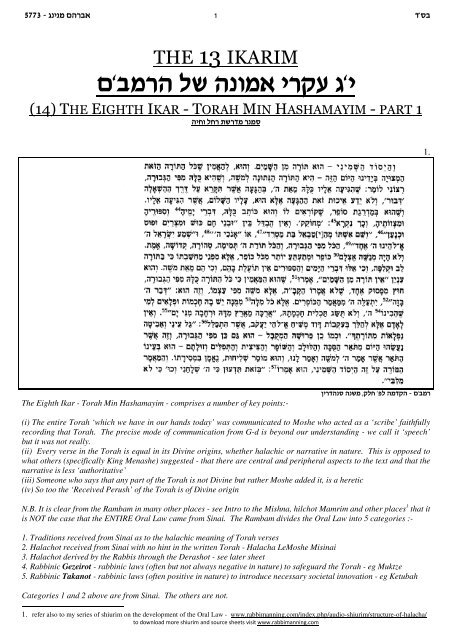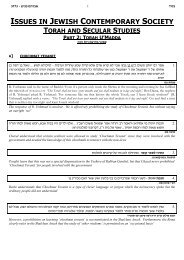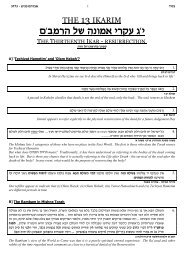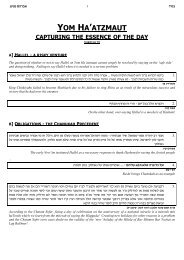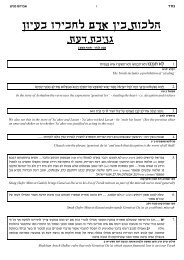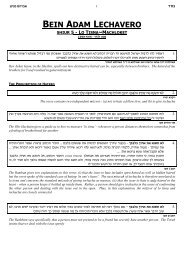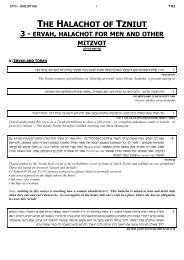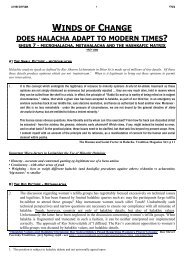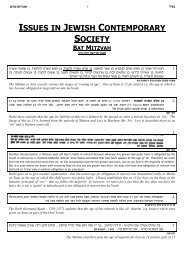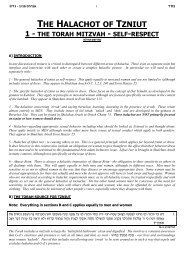The Eighth Ikar - Torah Min HaShamayim - Rabbi Anthony Manning
The Eighth Ikar - Torah Min HaShamayim - Rabbi Anthony Manning
The Eighth Ikar - Torah Min HaShamayim - Rabbi Anthony Manning
You also want an ePaper? Increase the reach of your titles
YUMPU automatically turns print PDFs into web optimized ePapers that Google loves.
5773 - dbhbn ovrct1sxcTHE 13 IKARIMocnrv ka vbunt hreg dh(14) THE EIGHTH IKAR - TORAH MIN HASHAMAYIM - PART 1vhju kjr ,arsn rbnx1.<strong>The</strong> <strong>Eighth</strong> <strong>Ikar</strong> - <strong>Torah</strong> <strong>Min</strong> Hashamayim - comprises a number of key points:-ihrsvbx vban 'ekj pk vnsev - ocnr(i) <strong>The</strong> entire <strong>Torah</strong> ‘which we have in our hands today’ was communicated to Moshe who acted as a ‘scribe’ faithfullyrecording that <strong>Torah</strong>. <strong>The</strong> precise mode of communication from G-d is beyond our understanding - we call it ‘speech’but it was not really.(ii) Every verse in the <strong>Torah</strong> is equal in its Divine origins, whether halachic or narrative in nature. This is opposed towhat others (specifically King Menashe) suggested - that there are central and peripheral aspects to the text and that thenarrative is less ‘authoritative’(iii) Someone who says that any part of the <strong>Torah</strong> is not Divine but rather Moshe added it, is a heretic(iv) So too the ‘Received Perush’ of the <strong>Torah</strong> is of Divine originN.B. It is clear from the Rambam in many other places - see Intro to the Mishna, hilchot Mamrim and other places 1 that itis NOT the case that the ENTIRE Oral Law came from Sinai. <strong>The</strong> Rambam divides the Oral Law into 5 categories :-1. Traditions received from Sinai as to the halachic meaning of <strong>Torah</strong> verses2. Halachot received from Sinai with no hint in the written <strong>Torah</strong> - Halacha LeMoshe Misinai3. Halachot derived by the <strong>Rabbi</strong>s through the Derashot - see later sheet4. <strong>Rabbi</strong>nic Gezeirot - rabbinic laws (often but not always negative in nature) to safeguard the <strong>Torah</strong> - eg Muktze5. <strong>Rabbi</strong>nic Takanot - rabbinic laws (often positive in nature) to introduce necessary societal innovation - eg KetubahCategories 1 and 2 above are from Sinai. <strong>The</strong> others are not.1. refer also to my series of shiurim on the development of the Oral Law - www.rabbimanning.com/index.php/audio-shiurim/structure-of-halacha/to download more shiurim and source sheets visit www.rabbimanning.com
5773 - dbhbn ovrct2sxc- har) hk g cU,F r p x ,K d n C h ,t c vB v h T rn t z t (j:n ohkv,) :wtba 'vb,hb vkhdn vkhdn - vru, :vtbc hcr ouan ibjuh r"t 2.vnu,j - vru, :rnut ahek ic a"r `(irp,u ihshdc irchj ,uharpv kf urndbaf vba wn ;uxcku vc,uf vhv vank varp vrntbafvbac uk ,urntbvu ikuf ,uharpv kf urntba rjtk wn ;ux sg vc,fb tk - har) v Z v vrIT v r p x , t j« ek (uf:tk ohrcs) tba 'vb,hb(ic,fa sg vp kg uk ,urusx uhv vhbau vbuatr/x ihyhdWhen was the Written <strong>Torah</strong> actually written? <strong>The</strong> Gemara gives two opinions - that the <strong>Torah</strong> was written in instalmentsand was ‘redacted’ on G-d’s instruction from an oral origin or that the <strong>Torah</strong> was written at the end of the 40 years and‘created’ at G-d’s instruction at the end of the 40 years 2 . No opinion holds that Moshe was given a Written <strong>Torah</strong> at HarSinai!vbunau urpx c,f gauvh :rn rnt ///// vru,ca oheuxp vbunau urpx c,f gauvh `cuhtu ogkc ,arpu urpx c,f van 3.hj van rapt /whh scg van oa ,nhu :whb,s 'ic,f gauvh vru,ca oheuxp vbuna :rnts itnf thb, /vru,ca oheuxp,"x rapt :a"r uk rnt //// vsuvh hcr hrcs 'iub ic gauvh c,f lkhtu itfn 'van c,f itf sg tkt ?van oa ,nhu c,fulkhtu itfn /c,ufu rnut vanu rnut v"cev itf sg 'tkt /vzv vru,v rpx ,t juek (t"k ohrcs) :ch,fu ?,jt ,ut rxjvK t v ohrc Sv kF , t hk t t r eh uh P n QUr C o vk r nt«H u(jh:uk uvhnrh) :ikvk rntba vnf /gnsc c,uf vanu rnut v"cev«uhSC r p X v k g c ,« F h bt u:sh tr,c tccChazal state that Moshe wrote ‘his book’ including the parsha of Bilaam (even though Moshe was not involved in oraware of it at the time.) <strong>The</strong>re is also a debate as to who wrote the last 8 pesukim of the <strong>Torah</strong>. R. Yehudah rules thatYehoshua wrote them. R. Shimon rules that they were written by Moshe but in a different way to the rest of the <strong>Torah</strong>.Normally, G-d would dictate the word, Moshe would repeat it and then write it down. However, Moshe wrote the last 8pesukim ‘in tears’. <strong>The</strong> mefarshim debate the meaning and implications of this expression.trzg hnhc ovk vb,hbu vrzj 'asuev iuaku hrcg c,fc ktrahk vru, vb,hb vkj,c :tceug rn tnh,htu tryuz rn rnt 4.itn /hnrt iuaku ,hrcg c,f ,uyuhsvk ujhbvu 'asuev iuaku ,hruat c,f ktrahk ivk urrhc /hnrt iuaku ,hruat c,fcivk lpvb - utyja iuhf 'ktrahk vru, vb,hb vz c,fc vkj,c :rnut hcr 'thb, ////// /ht,uf :tsxj cr rnt - ?,uyuhsvrzgkt hcr ouan rnta tyrp ic rzghkt hcr ouan rnut rzgkt ic iugna hcr ///// ovk urhzjv - ivc urzja iuhf '.gurkrehg kf vb,ab tk vz c,f :hgsunv:tf ihrsvbx<strong>The</strong>re is a debate in Chazal as to whether the original script of the <strong>Torah</strong> was the one we use today - Ktav Ashuri - or theCaananite script - Ktav Ivri2. For a fascinating series of shiurim by Mori VeRebbi R’ Meir Triebitz on the origins of the Written <strong>Torah</strong> based on this gemara in Gittin, seewww.hashkafacircle.com/shiurim/category/written-law/to download more shiurim and source sheets visit www.rabbimanning.com


